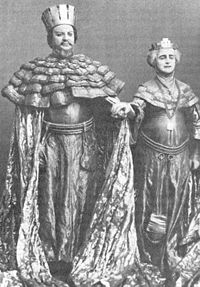Moscow Art Theatre production of Hamlet
Craig, an English theatre practitioner, had garnered interest for the symbolist and simplistic designs he brought to plays like Henrik Ibsen’s The Vikings at Helgeland.
On the other end of the spectrum Constantin Stanislavski was creating a world of theatre based upon realism, the internal complexities of the mind, and the rise of psychology.
As Benedetti stated, “Stanislavski hoped to use the production to prove that his recently developed 'system' for creating internally justified, realistic acting could meet the formal demands of a classic play”.
[7] Together they analysed the play scene-by-scene, then line-by-line, and devised a meticulous production plan, which included sound, lighting, and an outline of the blocking.
In the intervening period, Stanislavski had developed an important production of Turgenev's A Month in the Country, whose success had demonstrated the value of his new 'systematic' approach to the actor's work; he was keen to assay its virtues in the crucible of Shakespeare's tragedy.
When Stanislavski extended his invitation to Craig in April 1908, he was completely overcome by his eagerness to work with progressive theatre artists.
"[16] The playwright Maurice Maeterlinck (whom Stanislavski visited in the summer of 1908 to discuss his forthcoming production of The Blue Bird) had argued 15 years earlier that many of the greatest dramas in the history of theatre, including Hamlet, were "not stageable.
To support this interpretation, Craig wanted to add archetypal, symbolic figures—such as Madness, Murder, and Death—and to have Hamlet present on-stage during every scene, silently observing those in which he did not participate.
Craig had envisaged specially costumed, visible stage-hands to move the screens, but Stanislavski had rejected the idea.
This forced a curtain close and delay between scenes, which disrupted the sense of fluidity and movement inherent to Craig's conception.
For example, in the scene containing the dumb show Craig wished for the Actors to wear oversized masks, but Stanislavski despised this idea as it did not ring true to a realistic style of acting.
[28] The stage was divided sharply into two areas through the use of lighting: the background was brightly lit, while the foreground was dark and shadowy.
From a high throne upon which Claudius and Gertrude sat, which was bathed in a diagonal, bright golden beam, a pyramid descended, representing the feudal hierarchy.
The pyramid gave the illusion of a single, unified golden mass, from which the courtier's heads appeared to stick out through slits in the material.
On Claudius' exit-line the figures remained in place while the gauze was loosened, so that the entire court appeared to melt away before the audience's eyes, as if they had been a projection of Hamlet's thoughts that now had turned elsewhere.
However, Nikolay Efros, insisted that despite the flaws of the production, the theatre must be admired for the things that they aspired to achieve, and the immense amount of work they put in.
[30] The press in England was much kinder, and rumors spread very quickly through western Europe of the great triumph of Craig's vision, despite the production in actuality being a complete failure.
While Olga Knipper (Gertrude), Nikolai Massalitinov (Claudius) and Olga Gzovskaia (Ophelia) received poor reviews in the Russian press, Vasili Kachalov's performance as Hamlet was praised as a genuine achievement, one which succeeded in displacing the legend of Mochalov's mid-19th-century Romantic Hamlet.

